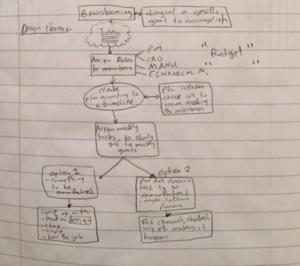The attatch picture demonstrates the design loop process in my point of view. It starts off by brainstorming the idea that is going to solve the problem and then deciding on what its going to be. Followed by dividing team roles if there was a team into creating a plan according to the available timeline. I then have two options depending whether its something to be manufactured or not. The main point is to find the cheapest and most efficient way of making something that solves the problem to accomplish the goal while still being aesthetic and good looking. What is not included is testing the product and iterating accordingly. Let me know if I missed any process or if you have any critique.
My upcycle project is making a key hanger, the point I reached now is the testing of the manufactured object. Testing includes examining how much weight the keys can handle. it turns out that one of the keys snapped as soon as I applied weight to it. The next move is to replace it with a more reliable bent key.


3 Comments. Leave new
[…] having a team and whether the product was to be manufactured of if it was a software. Click here to go the the blog of the old design loop […]
What a cool idea for a project! I like how you gave an overview of what steps could constitute a design process, and the contingencies you built into it. I also like how you provided insight into how you approached and solved a challenge that arose along the way. Is this the process that you used to create your upcycle project? If not exactly, what particular steps did you take or leave out?
Faisal, that’s a great representation of the design process because it includes contingencies on how the product will be made. One thing I’ve seen before is to include a Q-storming session immediately before brainstorming. This is a session to brainstorm all the important questions to ask so you can determine what questions will help you get to the right design criteria. This is based on the premise of “every question missed is a crisis waiting to happen.” Q-storming can help identify, challenge, and clarify the team’s assumptions and goals.